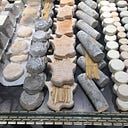Saint-Marcellin
Springtime in Lyon is not so different from that in Auckland. Days of rain have been randomly punctuated with brilliantly bright, sunny days, usually occurring partway through the week when they are of no use to anybody.
I don’t usually mind rain, but it is not particularly conducive to sightseeing, especially the kind of sightseeing I am most fond of, which consists of me wandering aimlessly around a city for hours. I’ve had to be reasonably inventive here in Lyon — for example, instead of going to La Cathédrale de la Saint-Jean, I’ve visited Muji instead.
While the markets along the banks of the Saône are unparalleled, there is one market which can be found under a roof — Les Halles de Lyon Paul Bocuse. Old mate Bocuse is one of Lyon’s most famous sons (along with the Lumière brothers, who invented cinema). He has three Michelin stars, and I am not ashamed to say that I had never heard of him until I heard about Les Halles.
The market is in a bleak building in the bleak 7th arrondissement, near a giant, bleak shopping centre that has a Primark in it that people queue to get into. I went on a rainy Saturday morning, and it was nothing short of bustling. Les Halles has a wide range of food vendors selling mostly meat (raw or cured), cheese, seafood or incredible-looking pastries. It also has several tiny, squished-in bistros that look like they were designed for train carriages.
I wandered around for a bit looking at the various offerings and peering anxiously into restaurants trying to decipher the menus, before turning toward my day’s main task — to come away with a wheel of Saint-Marcellin cheese, Lyon’s fromage célèbre.
Saint-Marcellin is in the brie family of cheeses, although it is not as strongly flavoured as its more famous forebear. It is made from unpasteurised cows’ milk and is mould-ripened, although the rind tends to be very thin and powdery.
Like many other cheeses in France, Saint-Marcellin has an AOP classification, which means that only cheese made in a particular geographical location (in this case from the area around the town of Saint-Marcellin a little way southwest of Lyon) and made according to a strict set of rules can be given the name Saint-Marcellin.
This is the same system that famously protects the name Champagne, and is widely used around the European Union. Parmesan has the Italian version of an AOP (NZ-made “parmesan” would be illegal in the EU), and even the humble Cornish pasty is protected under EU law (for now, anyway). The French love their protected designations of origin — this morning I was reading about the AOPs of various breeds of French chickens.
Saint-Marcellin is everywhere in Lyon, and every vendor selling cheese at Les Halles had a tiny pyramid of powdery, wrinkled wheels. After a truly terrifying encounter with a French person in which I was forced to reveal the fact that I didn’t speak French very well, I fulfilled my goal, and came away with a cheese to eat with baguette (and a cheeky tarte aux praline for dessert).
The cheese was not as runny as the internet had led me to believe it would be, although it was plump and soft and gooey, for sure. It was, however, rustic af, with a earthy, tangy vibe that reminded me quite a lot of fino sherry, of all things. I paired it with a glass of light, herby Vin de Savoie from the Apremont cru, mostly because that’s what was open in the fridge. It was a fortuitous pairing, however — the two were very complementary, the wine’s crisp fruitiness cutting through the rich cheese.
Overall, I liked the Saint-Marcellin. It wasn’t the most delicious thing I have ever eaten in my life — but I think it is not the kind of cheese that is given to extravagance. It’s the Côte du Rhône of cheeses — nothing fancy, the kind of thing you crack open on a Thursday night cos you’re hungry and the goddang curry you’re making is taking an age to cook.
Type of cheese: Saint-Marcellin
Eaten with: Vin de Savoie Apremont
Score: 6 out of 10 laughing cows

